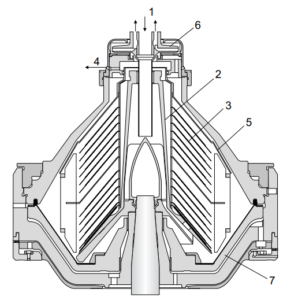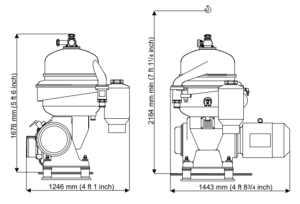Home » Separators » Alfa Laval Separators »
Alfa Laval AFPX 513 Separator
Alfa Laval AFPX separator centrifuges were specially designed for extremely demanding separation jobs. Key features of the AFPX 513 centrifuge are its ability to handle high flow rates, high solids content and high-temperature processing. These functions make it the ideal choice to handle the tough conditions encountered in the animal and fish processing industries. In addition, the AFPX 513 centrifuge combines a high G-force, high sludge capabilities and automated operation.
Applications
The AFPX 513 was designed to discharge solids intermittently, while at the same time splitting a tight emulsion of two liquid phases. The centrifuge comes in a series of optimized models that are suitable for a considerable number of duties, including separating fish press water, stick and glue water as well as meat and fish extracts. Other applications include the purification of fish oil and fish liver oil, animal fat, peel oil, and similar products.
Performance
The actual throughputs depend on variables such as the amount and type of solids, the temperature, viscosity and degree of separation required. The following figures indicate the rate of performance, although no guarantees are given.
| Separation – fish press water | 12.000–18.000 l/h | (50–80 US gpm) |
| Purification – fish oil | 6.000– 8.000 l/h | (25–35 US gpm) |
| Purification – animal fat | 3.000– 6.000 l/h | (13–25 US gpm) |
Standard design
The machine consists of a frame that has a horizontal drive shaft with brake, worm gear, lubricating oil bath and vertical bowl spindle in the lower part. The bowl is mounted on top of the spindle, inside the space formed by the upper part of the frame, the ring solids cover, the oil collecting cover, and the frame hood. The feed and liquid discharge system, including the paring disc pump for the heavy phase, also rests on this structure. All metallic parts in contact with the process liquid are made of stainless steel. The bowl is of the solids-ejecting disc type with a hydraulic operating system for “shooting” (for automatic or manual operation). The electric motor is either of the controlled torque type or of the standard type for frequency control drive.
Basic equipment
Concentrator or purifier parts, inlet and outlet devices, revolution counter, set of erosion-protective parts, illuminated sight glass box for light phase outlet, vibration switch, vibration-isolating base plate, flange motor, set of tools and standard set of spares.
Optional extras
Starter equipment, discharge program equipment, standard set of fittings.
Material data
| Bowl body, hood and lock ring | s.s. 1.4462 UNS S31803 |
| Solids cover and frame hood | s.s. 1.4401 UNS 31600 |
| Frame bottom part | grey cast iron |
| In and outlet parts | s.s. mostly 1.4401 UNS 31600 |
| Gaskets and O-rings | Nitrile rubber |
Operating principles
Separation takes place inside a rotating bowl. The feed is introduced to the rotating centrifuge bowl from the top via a stationary inlet pipe (1), and is accelerated in the distributor (2), which was specially designed to ensure smooth acceleration of the feed liquid. Leaving the distributor, the feed enters the disc stack (3). The separation into liquid–liquid–solids takes place between the discs, with the oil phase moving through the disc stack to the centre. When it reaches the centre, it is discharged through channels (4) and ejected into the collecting frame. The water and heavy solids separated from the oil move to the periphery, and the water flows via channels in the top disc (5) to the paring chamber, where it is pumped out of the rotor by means of a built-in paring disc (6). During purification, water is fed into the bowl before the process liquid is introduced. This water forms a seal around the outer edge of the top disc. The solids collect in the periphery, where they are discharged intermittently via the centrifuge cyclone. The solids are discharged by means of a hydraulic system, which forces the sliding bowl bottom (7) to drop down at preset intervals, thus opening the solids ports at the bowl periphery.
Basic executions
Purifier AFPX 513XGD-14CG: Purifies the light liquid phase, which is the major part of the feed mixture.
Concentrator AFPX 513XGD-74CG: Purifies the heavy liquid phase, which is the major part of the feed mixture. The light phase becomes concentrated.
Energy consumption
| Electric power at 18 m3 /h | 18 kW |
| Operating liquid per discharge | 0.6 l |
Dimensions

Technical specification
| Hydraulic capacity | 37 m3/h (60 US gpm) |
| Bowl speed | 5,120 rpm |
| Motor speed synchronous 50/60 Hz | 1,500/1,800 rpm |
| Centrifugal force inside bowl | max. 7,520 g |
| Bowl volume | 38 l |
| Sludge space volume | approx. 12 l |
| Motor power installed | 30 kW |
| Starting time | 8–10 min |
| Stopping time with brake | 7–8 min |
| Outlet pressure, oil | 0 kPa |
| Outlet pressure, heavy phase | max. 600 kPa |
| Sound pressure | 83 dB(A) |
| Overhead hoist lifting capacity | min. 800 kg (1,764lbs) |
